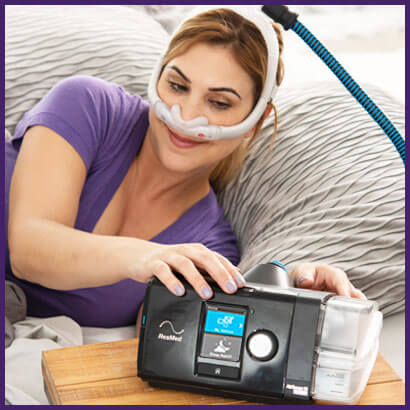

April showers bring may flowers, which means trouble for those with allergies. This is especially true for CPAP users. How do you continue using your much-needed CPAP machine when you have a serious case of sinus congestion?
Fortunately, we have a number of tips that can help you. Not only will you be able to make it through the dreaded allergy season without having to give up your CPAP therapy, you’ll also be well-rested to enjoy the beautiful spring weather!
1. Use a full face mask
Since your nose will likely be out of commission, the best course of action is to purchase a full face CPAP mask. This will let you continue enjoying the benefits of CPAP therapy while you wait for your congestion to go away.
If you are a nasal or nasal pillow user who’s looking for a more minimal style, try either the AirFit F30 or the DreamWear Full Face. These are great alternatives and will be more similar to the style you’re accustomed to.
2. Use an auto-titrating CPAP machine
Many CPAP users still rely on traditional machines that provide one level of air pressure throughout the night. However, this may not be ideal when you’re combating allergy symptoms. For that reason, you may want to look into an auto CPAP machine.
These machines automatically adjust the air pressure being delivered during the night. This continuous adjustment will make your therapy more comfortable when your sinuses are congested.
3. Use a heated humidifier
The biggest problem with using your CPAP machine while you have allergies is the buildup of phlegm and swollen membranes in your nose. One way to deal with this is by using a heated humidifier.
A heated humidifier pumps warm, moist air through your CPAP, helping you restore the moisture levels to your nasal passages. This will make it easier for you to sleep comfortably and to continue using your CPAP machine.
4. Disinfect your supplies with a CPAP Sanitizer
It’s essential to keep your CPAP germ-free so you don’t get sick on top of having allergies. Sometimes symptoms of allergies can be mistaken for symptoms of a cold, but you won’t realize you’re sick until you come down with a fever. Or if your allergies aren’t treated effectively, your immune system can be weakened and the introduction of viruses can cause your allergies to turn into a sinus, ear, or upper respiratory infection.
There are automated CPAP sanitizers that kill 99% of germs and bacteria and require no hand washing, soap, or water. The SoClean, Sleep8, or Lumin are all great sanitizing options that act as a preventative measure to ensure that you don’t add on to your allergies.
5. Sleep in an elevated position


Often, CPAP users that are also back sleepers have the most trouble sleeping during allergy season. Nasal congestion is often much more uncomfortable for back sleepers, which makes it difficult to utilize a CPAP machine.
One way around this is to sleep in an elevated position. By simply putting a few pillows under your neck, you’ll decrease the amount of mucus buildup. If this doesn’t help, you could also try sleeping on your side.
6. Try a nasal aid or other decongestant
Nasal decongestants are a good way to combat nighttime stuffiness. For instance, Nasal Aid is a strip that goes over the bridge of your nose and helps expand your nasal passages during sleep. This makes it easier to utilize a nasal or nasal pillow mask.
Users can also take advantage of over-the-counter nasal spray or antihistamine sprays.


















